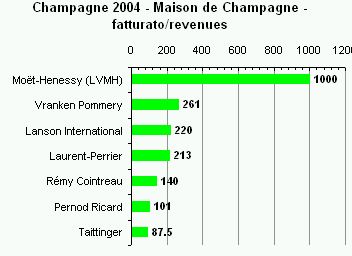[English inside]
I bilanci di Laurent Perrier e Vranken Pommery ci consentono di analizzare la struttura competitiva della Champagne, che riveste un particolare interesse nel mondo del vino: stiamo parlando di oltre 300m di bottiglie vendute ogni anno che escono dai produttori a EUR13 l’una e che vengono prodotte con oltre 100q/ha di resa.
Gli esperti suddividono queste 300m di bottiglie in 3 parti: le cooperative circa 28m, i “vigneron” 72m e le “Maison de Champagne” per i restanti 207m (cioe’ i due terzi).

La frammentazione del mercato resta rilevante: i primi 7 gruppi tra le Maison coprono circa 127m di bottiglie, cioe’ il 42% del totale. Il leader indiscusso e’ LVMH, con un fatturato di EUR1bn e 53m di bottiglie, cioe’ circa il 18% del totale del mercato. Seguono Vranken Pommery (di cui parleremo), Lanson e Laurent-Perrier.

Passiamo a una visuale piu’ chiara della struttura del mercato: dopo LVMH ci sono 3 gruppi della taglia di 200-250m di fatturato, poi un’altro salto nella fascia 80-140m. Tutti questi produttori vantano dei tassi di crescita superiori a quelli del mercato della Champagne, stiamo intorno al 5-6% annuo contro un 2-3% del mercato. Tendono quindi a guadagnare quote di mercato, presumibilmente in forza a una capacita’ superiore di investimento e alla forza dei loro marchi (che vedete elencati nella tabella finale).

Altri due grafici sui volumi e sul prezzo medio per bottiglia. LVMH non solo e’ il leader di volumi ma anche in termini di prezzo medio, con EUR19 per bottiglia, poco sotto Taittinger (che pero’ fa 4.4m di bottiglie contro 53…). Laurent-Perrier a EUR17 e’ poco sotto, mentre la divisione Champagne di Pernod Ricard e quella di Lanson sono largamente inferiori (a 9 e 12 euro).


Infine, la tabella dei dati con i marchi. Beh, parlare di Moët & Chandon, Ruinart, Veuve-Clicquot + Krug e Dom Pérignon rende l’idea di come fa LVMH a fare 53m di bottiglie a EUR19; ugualmente Pommery per Vranken e Laurent-Perrier…

Laurent-Perrier and Vranken Pommery company reports allow us to give a look to the competitive structure of Champagne, whichi is very important in the wine industry: over 300m bottles with a average price per bottle of EUR13 and a yield of over 100q/ha. The industry is split in 3 categories: cooperatives with 28m bottles, “vigneron” with 72m and “Maison de Champagne” with the remaining 207m (two thirds).
Moving to a more analytical view we discover that the undisputed market leader is LVMH, followed by 3 producers with 200-250m euro of sales and another 3 with 80-140m. All these producers are growing by 5-6% a year vs. a 2-3% normalised growth for the Champagne region. They tend therefore to consolidate the market, probably thanks to a superior investment capacity and thanks to their brands (see table at the end).
The two other graphs are for volumes and price per bottle. LVMH is not just the leader in terms of volumes but also looking at the average selling price, with EUR19 per bottle, just below the EUR20 of Taittinger (which however sells 4.4m bottles vs. the 53m of LVMH!). Just below this threshold there is Laurent-Perrier at EUR17, while Champagne dision of Pernod Ricard and Lanson are clearly below this level (EUR9 and EUR12 respectively).
Finally you can find the table with the brands and all data. When you look at the list of LVMH brands you clearly understand the reason of the leadership both in terms of volumes and prices: Moët & Chandon, Ruinart, Veuve-Clicquot + Krug e Dom Pérignon can well justify a EUR1bn of sales!
Moët-Henessy (LVMH) (Moët & Chandon, Ruinart, Veuve-Clicquot + Krug, Dom Pérignon etc.
Vranken Pommery (Vranken Pommery, Charles Lafitte, Heidsieck Monopol)
Lanson International (Lanson, Alfred Rothschild, Besserat de Bellefon)
Laurent-Perrier (Laurent-Perrier, de Castellane, Château Malakoff, Salon etc.)
Rémy Cointreau (Piper-Heidsieck, Charles Heidsieck)
Pernod Ricard (Mumm, Perrier-Jouët – bought in July 2005 from Allied Domecq)
Taittinger (bought end of July by Starwood Capital, an investment fund)

